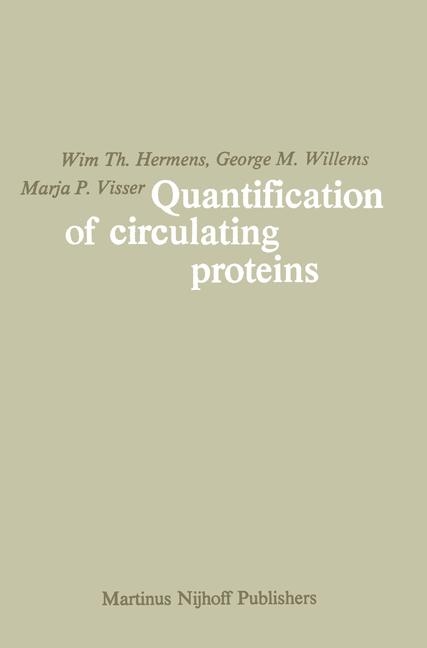
Quantification of Circulating Proteins
Kluwer Academic Publishers (Verlag)
978-90-247-2755-1 (ISBN)
- Titel ist leider vergriffen;
keine Neuauflage - Artikel merken
1: Introduction.- 1.1 Quantitative description of circulating proteins.- 1.2 Presentation of theory and applications.- A: Physiological basis, choice of models and quantitative methods.- 2: Turnover and distribution of circulating tissue enzymes.- 2.1 Introduction.- 2.2 Variability of tissue enzyme content.- 2.3 Relation between leakage of cellular enzymes and cell death.- 2.4 Enzyme release from different cellular compartments.- 2.5 Pathways for the transport of cellular proteins from tissues to plasma.- 2.6 Factors preventing tissue enzymes from reaching circulation.- 2.7 Elimination of tissue enzymes from circulation.- 3: Turnover and distribution of plasma proteins.- 3. 1 Introduction.- 3.2 Delivery of plasma proteins to circulation.- 3.3 Exchange of protein between plasma and extravascular compartments.- 3.4 Elimination of plasma proteins from circulation.- 3. 5 Variability of circulatory parameters in man.- 4: Methods and models used in quantitative studies of circulating proteins.- 4.1 Introduction.- 4.2 Basic compartmental models.- 4.3 Equivalence of different methods and formalisms.- 4.4 Quantification of in vivo release of protein.- 5: Sources of error in quantification of circulating proteins.- 5.1 Introduction.- 5.2 Hazards in estimating circulatory parameters from tracer kinetics.- 5.3 Errors caused by purification and labeling.- 5.4 Accuracy in calculation of cumulative protein release.- 5.5 Behaviour of circulating proteins in the dog.- B : Applications.- 6: Assessment of myocardial damage from plasma levels of cardiac enzymes.- 6 1 Introduction.- 6.2 A model for circulating cardiac enzymes.- 6.3 Estimation of catabolic rate constants.- 6.4 Accuracy in calculation of cumulative release of cardiac enzymes.- 6.5 The extent of myocardial damage after acute myocardial infarction.- 6.6 The extent of myocardial damage after open-heart surgery.- 7: Changes in circulating mass of plasma proteins during the acute phase response.- 7.1 Introduction.- 7.2 Plasma volume changes after acute myocardial infarction.- 7.3 Plasma volume expansion and the negative acute phase response.- 7.4 Consumption of proteinase inhibitors in the acute phase after myocardial infarction.- 7.5 Calculation of catabolic rate constants from the acute phase response.- 8: Dose-calculation of blood coagulation factors for infusion therapy.- 8.1 Introduction ..- 8.2 A model for circulating coagulation factors.- 8.3 Estimation of circulatory parameters for different coagulation factors.- 8.4 Effects of a single dose, intermittent doses and continuous infusion.- 8. 5 Complications in dose calculation.- 9: A review of data on the turnover and distribution of circulating proteins.- 9.1 Experimental procedures.- 9. 2 Techniques for the analysis of data.- 9.3 List of plasma proteins.- 9.4 Circulatory parameters for plasma proteins in man.- 9.5 Circulatory parameters for plasma proteins in the dog, rabbit and rat.- 9. 6 List of circulating tissue enzymes.- 9.7 Circulatory parameters for tissue enzymes in man.- 9.8 Circulatory parameters for tissue enzymes in the dog,rabbit and rat.- Appendix: Derivation of mathematical expressions.- References.
| Zusatzinfo | 264 p. |
|---|---|
| Verlagsort | Dordrecht |
| Sprache | englisch |
| Gewicht | 610 g |
| Themenwelt | Medizinische Fachgebiete ► Innere Medizin ► Hämatologie |
| ISBN-10 | 90-247-2755-3 / 9024727553 |
| ISBN-13 | 978-90-247-2755-1 / 9789024727551 |
| Zustand | Neuware |
| Informationen gemäß Produktsicherheitsverordnung (GPSR) | |
| Haben Sie eine Frage zum Produkt? |
aus dem Bereich


